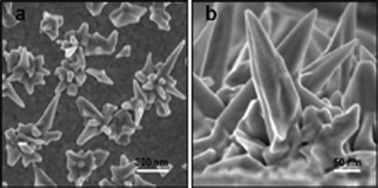This paper reports a simple, one-step, template-free surface assisted growth of crystalline branched-like Au nanoparticles (three-dimensional (3-D) growth with more than 12 tips) with high yield and good size monodispersity at room temperature. The size of the Au branched nanocrystals could be tuned by controlling the composition of the starting reaction mixture (growth solution). The key surface growth strategy was to use a 1,6-hexanedithiol (HDT) monolayer-modified electrode immersed into growth solution to confine the growth of the branched Au nanocrystals on their surface. Time-course measurements by field emission-scanning electron microscopy (FESEM) were used to follow the reaction progress and the evolution of the branched-like nanocrystal shape. The Au nanocrystals exhibited strong surface enhanced effects which were utilized in the design of an efficient, stable, and Raman-active tag for biosensors, and electrocatalytic applications.
You have access to this article
 Please wait while we load your content...
Something went wrong. Try again?
Please wait while we load your content...
Something went wrong. Try again?


 Please wait while we load your content...
Please wait while we load your content...